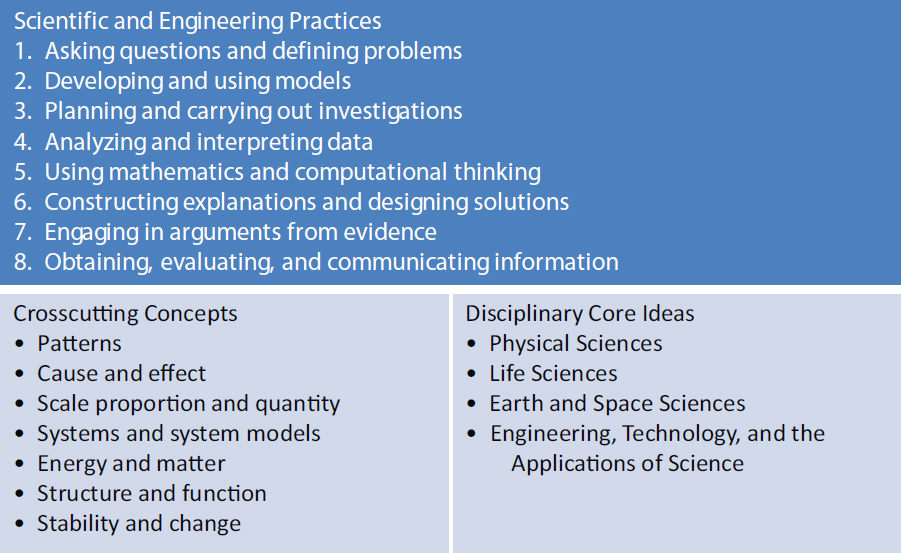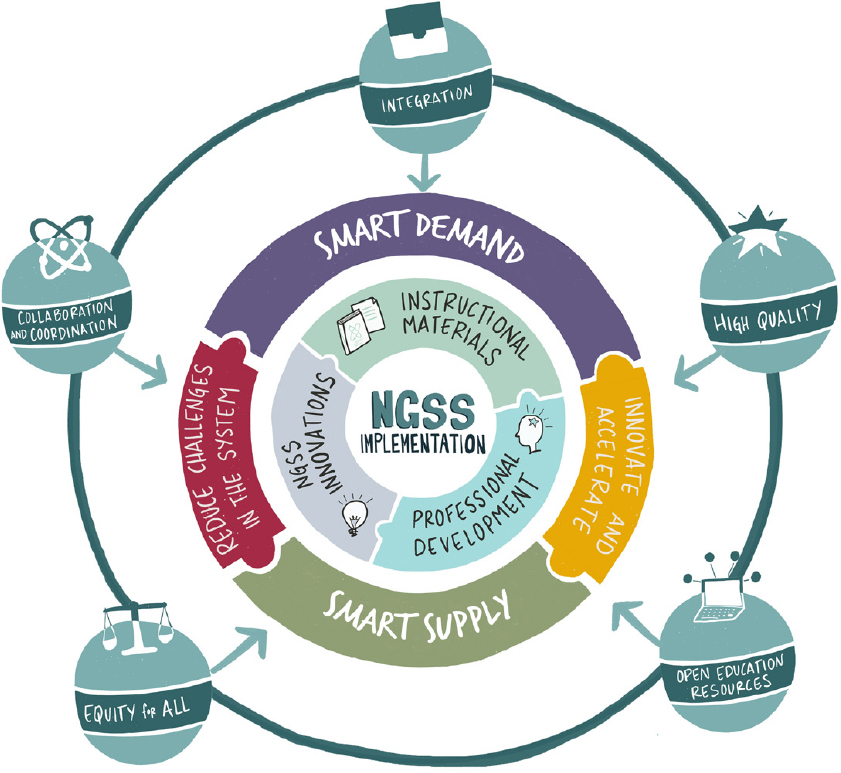1
INTRODUCTION
THE IMPORTANCE OF SCIENCE EDUCATION AND INSTRUCTIONAL MATERIALS
Instructional materials are a key means to achieving the goals of science education—an enterprise that yields unique and worthwhile benefits to individuals and society. Science itself is a democratizing force, stated Rush Holt, chief executive officer for the American Association for the Advancement of Science, in the keynote address at the Workshop on the Design, Selection, and Implementation of Instructional Materials for the Next Generation Science Standards (NGSS), convened June 27–28, 2017, in Washington, DC. Science arms citizens with a way to ask questions that can be answered empirically and verifiably, he continued, and it provides the best insurance against deception from oneself or others. The same logic that leads from one scientific finding to another can also inform individual lives and public policy, he added.
Whether science is learned in a formal school setting or outside of school, science education is about teaching the process for understanding how physical, biological, or geological systems work. To do this, explained Holt, science education cannot focus only on the facts that science has yielded. Instead, it needs to equip citizens to recognize evidence and, when possible, to collect the evidence and analyze it for themselves. The goal is not to produce scientific experts. Though laudable, models of science education designed to produce world-class scientists and engineers also leave behind the vast majority of citizens. Science education for all should be focused on empowering citizens, according to Holt.

SOURCE: National Research Council (2012).
Transformations in the way that science is taught across the country are underway. These changes at the elementary and secondary level have been shaped primarily by A Framework for K–12 Science Education (hereafter referred to as “the Framework”; National Research Council, 2012) and the Next Generation Science Standards: For States, By States (hereafter referred to as “the NGSS”; NGSS Lead States, 2013). The NGSS were authored by a consortium of 26 states facilitated by Achieve, Inc., and were released in 2013. These standards are based on the Framework, which was developed under the auspices of the Board on Science Education at the National Academies of Sciences, Engineering, and Medicine. Together, these two documents provide guidance for improving science education that both builds on previous national standards for science education and reflects research-based advances in learning and teaching science. The three dimensions of science learning are described in the Framework and inform the design of the NGSS (see Figure 1-1).
As of December 2017, 19 states, the District of Columbia, and the Department of Defense Education Activity have adopted the NGSS. Moreover, 13 other states have adopted science standards since 2013. They have used the
vision of the Framework as a guide for improving science instruction and revising their own standards. Additionally, many districts have taken advantage of local options and have independently decided to implement the NGSS. As states and districts move forward with adoption and implementation of the NGSS or work on improving their instruction to align with the Framework, instructional materials that align with this new vision for science education have emerged as one of the key mechanisms for creating high-quality learning experiences for students.
James Short of the Carnegie Corporation of New York highlighted a model developed by Richard Elmore (2008). The model suggests that to improve student learning at scale, three levers must be raised simultaneously: (1) teachers’ knowledge and skill through professional learning, (2) the level of content through standards and assessments, and (3) the level of students’ active learning through instructional materials.
Improvements in these areas—professional learning, standards of assessment that reflect the content in the NGSS, and instructional materials—are also supported by fostering smart supply of and demand for them, while reducing barriers and accelerating innovation, as depicted in Figure 1-2. According to Short, “smart” supply and demand requires adhering to key principles and approaches “to guide the implementation, to guide how we integrate and [collaborate and coordinate] with the different stakeholders that result in high-quality, open education resources and address equity and access for all students.”
GOALS OF THE WORKSHOP
Many efforts are underway to support the design and implementation of instructional materials for science education in ways that build from the Framework. In response to the need for more coordination across these efforts, the Board on Science Education at the National Academies of Sciences, Engineering, and Medicine convened a public workshop on June 27–28, 2017. The workshop focused on the development of instructional materials that reflect the principles of the Framework and the NGSS, as described in the planning committee’s Statement of Task (see Box 1-1).
According to the workshop planning committee chair, Michael Lach, the committee examined the vast array of strategies that schools, districts, and states are using to enact the NGSS and sought to determine the role of instructional materials in those strategies. The committee designed the workshop to explore what the NGSS look like in instructional materials and tools for measuring quality, how the complex systems and marketplace of instructional materials affect the

SOURCE: Bybee and Chopyak (2017).
adoption of materials, the role of instructional materials in fostering educational equity, and the steps needed to implement the materials in the classroom to benefit students. The planning committee also sought to learn ways to apply lessons learned in English Language Arts and mathematics to science education.
ORGANIZATION OF THIS PROCEEDINGS
The workshop was organized by an independent planning committee in accordance with the procedures of the National Academies of Sciences, Engineering, and Medicine. (See Appendix A for the agenda and Appendix B for biographical
information for the committee members and presenters.) This proceedings summarizes the discussions that occurred throughout the workshop and highlights the key points raised during the presentations, moderated panel discussions, breakout groups, and open discussions among the workshop participants. Chapter 2 presents the current state of efforts to implement the NGSS. Chapter 3 describes
existing tools and approaches for addressing challenges with developing and selecting instructional materials that faithfully align with the NGSS, important elements of materials to consider, and ways that lessons learned from mathematics education might be applied to science education. Chapter 4 describes models for development, distribution, and adoption of materials. It also features discussion of the market for instructional materials and how teachers identify and use materials. Chapter 5 focuses on issues of implementation—designing for equity, meeting the professional learning needs of teachers, and building capacity in the system. Chapter 6 presents participant ideas for next steps (also see Appendix C).1
In accordance with the policies of the National Academies, this proceedings has been prepared by the workshop rapporteur as a factual summary of what occurred at the workshop. The workshop did not attempt to establish any conclusions or recommendations about needs and future directions, focusing instead on issues identified by the speakers and workshop participants. Statements, recommendations, and opinions expressed are those of individual presenters and participants, do not necessarily represent the views of all workshop participants or the planning committee, and are not necessarily endorsed or verified by the National Academies. They should not be construed as reflecting any group consensus. The planning committee’s role was limited to setting the agenda and convening the workshop.
___________________
1 Videos of presentations and additional materials prepared or compiled for this workshop can be found at http://sites.nationalacademies.org/DBASSE/BOSE/CurrentProjects/DBASSE_179325 [December 2017].






